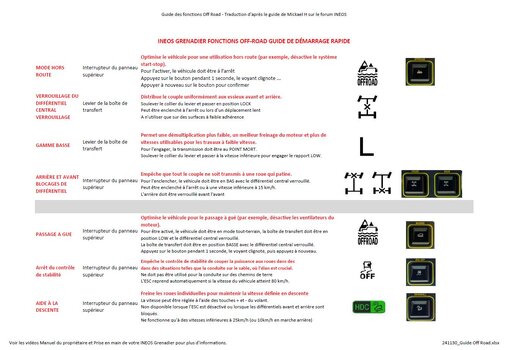The Grenadier Forum
Register a free account today to become a member! Once signed in, you'll be able to contribute to the community by adding your own topics, posts, and connect with other members through your own private inbox! INEOS Agents, Dealers or Commercial vendors please use the contact us link at the bottom of the page.
Off Road Functions Quick Start Guide
- Thread starter Michael H.
- Start date
-
- Tags
- off road
CENTRE DIFFERENTIAL LOCK:
When open TORQUE is equal on both propshafts. Power is rotational speed x torque. If rotational sppeds are different power on propshafts are different.
When locked ROTATIONAL SPEEDS are equal but in case traction on front and rear axles are different also torque and thus power are different.
Therefore "Distributes torque evenly to the front and rear axles" is valid when centre differential is OPEN, not locked.
But with all three diffferentials open the total available torque (=driving force) is 4 x lowest wheel torque, which means if traction is completely lost on one wheel (wheel in air) the total force driving car forward is zero. With locked centre differential it is 2 x lower front wheel torque + 2 x lower rear wheel torque. Cross axled condition (one front and one rear wheel in air) will still loose all driving force.
I would recommend the text "Locking the centre differential improves driving force by connecting front and rear propshats."
And I would change "May be engaged when stopped or moving slowly (under 40km/h)" to "May be engaged in any speed when there is no wheel spin."
And for REAR AND FRONT DIFFERENTIAL LOCKS "Prevent all the torque going to a slipping wheel" is not correct as in this condition torque on both wheels are equal (the smaller wheel's torque). Better would be "Use all traction available on both wheels".
When open TORQUE is equal on both propshafts. Power is rotational speed x torque. If rotational sppeds are different power on propshafts are different.
When locked ROTATIONAL SPEEDS are equal but in case traction on front and rear axles are different also torque and thus power are different.
Therefore "Distributes torque evenly to the front and rear axles" is valid when centre differential is OPEN, not locked.
But with all three diffferentials open the total available torque (=driving force) is 4 x lowest wheel torque, which means if traction is completely lost on one wheel (wheel in air) the total force driving car forward is zero. With locked centre differential it is 2 x lower front wheel torque + 2 x lower rear wheel torque. Cross axled condition (one front and one rear wheel in air) will still loose all driving force.
I would recommend the text "Locking the centre differential improves driving force by connecting front and rear propshats."
And I would change "May be engaged when stopped or moving slowly (under 40km/h)" to "May be engaged in any speed when there is no wheel spin."
And for REAR AND FRONT DIFFERENTIAL LOCKS "Prevent all the torque going to a slipping wheel" is not correct as in this condition torque on both wheels are equal (the smaller wheel's torque). Better would be "Use all traction available on both wheels".
Last edited:
Thanks very much for the help.
I’ll put up another draft once I review any other suggestions I receive.
I'm not sure of the exact speed up to which the centre diff can be locked. Hopefully someone knows.
I think the 3 pre-requisites for Wading Mode could be done in any order.
To lock the center differential, first stop the vehicle and put the gear in neutral.
Then move the differential case selector to High Lock or Low Lock. In other words, the vehicle should not move.
C'est étrange, pourquoi ne pas publier cela dans la partie francophone du Forum?Bonjour à tous
La version française à partir du travail réalisé par Mickael H.
It's ok to lock/unlock the centre diff in both high and low range while on the move below 40km/hrTo lock the center differential, first stop the vehicle and put the gear in neutral.
Then move the differential case selector to High Lock or Low Lock. In other words, the vehicle should not move.
Bonjour et merci de la précision. Je ne sais pas comment faire pour poster dans la fête franconphone.C'est étrange, pourquoi ne pas publier cela dans la partie francophone du Forum ?:incertain:
Merci de votre aide.
Bon, je suis surpris, je croyais que vous étiez "modérateur" de la partie francophone?Bonjour et merci de la précision. Je ne sais pas comment faire pour poster dans la fête franconphone.
Merci de votre aide.
C-joint le lien:
French language Forum
Good post.CENTRE DIFFERENTIAL LOCK:
When open TORQUE is equal on both propshafts. Power is rotational speed x torque. If rotational sppeds are different power on propshafts are different.
When locked ROTATIONAL SPEEDS are equal but in case traction on front and rear axles are different also torque and thus power are different.
Therefore "Distributes torque evenly to the front and rear axles" is valid when centre differential is OPEN, not locked.
But with all three diffferentials open the total available torque (=driving force) is 4 x lowest wheel torque, which means if traction is completely lost on one wheel (wheel in air) the total force driving car forward is zero. With locked centre differential it is 2 x lower front wheel torque + 2 x lower rear wheel torque. Cross axled condition (one front and one rear wheel in air) will still loose all driving force.
I would recommend the text "Locking the centre differential improves driving force by connecting front and rear propshats."
And I would change "May be engaged when stopped or moving slowly (under 40km/h)" to "May be engaged in any speed when there is no wheel spin."
And for REAR AND FRONT DIFFERENTIAL LOCKS "Prevent all the torque going to a slipping wheel" is not correct as in this condition torque on both wheels are equal (yhe smaller wheel's torque). Better would be "Use all traction available on both wheels".
It is intuitively difficult to understand that an open diff distributes torque equally!
- Local time
- 4:14 AM
- Joined
- Sep 25, 2021
- Messages
- 420
Similar to my Defender 90, except that the locking (and gearing range change) function of the lever operates in the opposite direction.It's ok to lock/unlock the centre diff in both high and low range while on the move below 40km/hr
By nature open differential is a torque equalizing device. If one wheel is spinning there is equal torque on the other despite it's not rotating.It is intuitively difficult to understand that an open diff distributes torque equally!
OMFG...CENTRE DIFFERENTIAL LOCK:
When open TORQUE is equal on both propshafts. Power is rotational speed x torque. If rotational speeds are different power on propshafts are different.
When locked ROTATIONAL SPEEDS are equal but in case traction on front and rear axles are different also torque and thus power are different.
Therefore "Distributes torque evenly to the front and rear axles" is valid when centre differential is OPEN, not locked.
Finally, finally, somebody said what I've been saying for years.
That applies to open and locked axle differentials, with propshafts replaced by axleshafts.
Similar threads
- Replies
- 5
- Views
- 553
- Replies
- 0
- Views
- 365
- Replies
- 3
- Views
- 317
- Replies
- 35
- Views
- 2K




